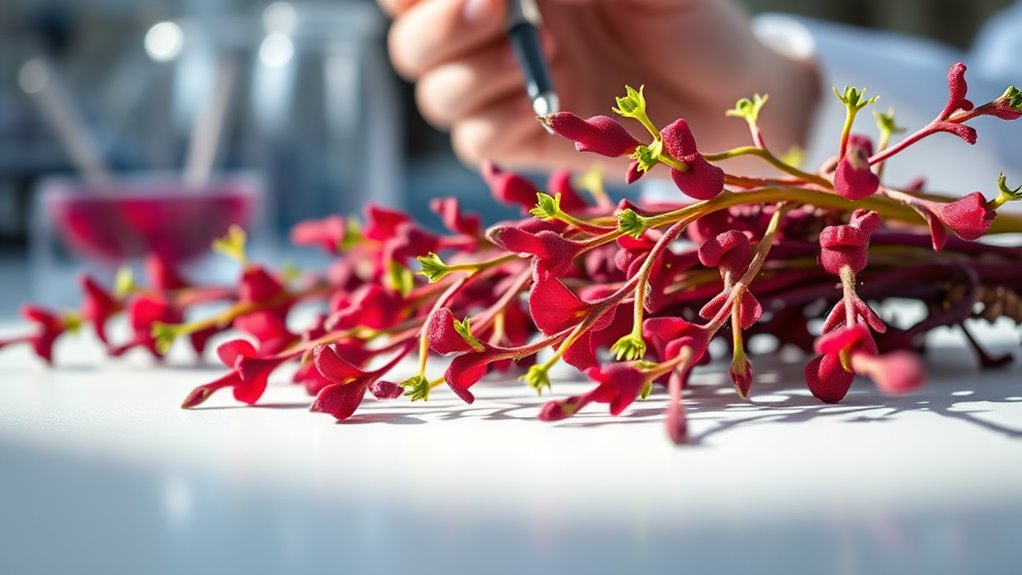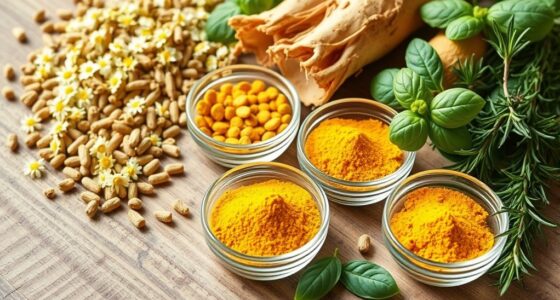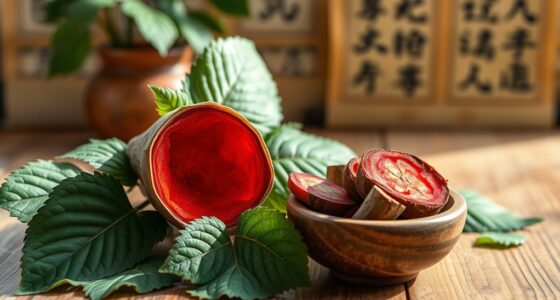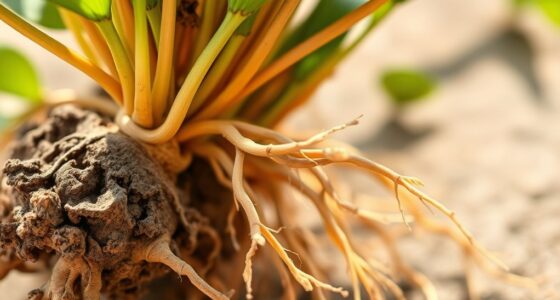Salvia miltiorrhiza, or Danshen, contains compounds like tanshinones and salvianolic acids that boost bone formation, inhibit breakdown, and reduce inflammation and oxidative stress. It influences bone cells by promoting osteoblast activity while repressing osteoclasts, helping maintain strong, healthy bones. Its anti-inflammatory and antioxidant effects support long-term bone integrity, especially for osteoporosis prevention and management. If you keep exploring, you’ll discover how this herbal approach fits into all-encompassing bone health strategies.
Key Takeaways
- Salvia miltiorrhiza promotes osteoblast activity and inhibits osteoclasts, supporting bone formation and reducing bone resorption.
- Contains bioactive compounds like tanshinones and salvianolic acids that aid in bone regeneration and mineralization.
- Exhibits anti-inflammatory and antioxidant properties that protect bone tissue from chronic inflammation and oxidative stress.
- Activates signaling pathways such as BMP and Wnt, which are crucial for bone remodeling and density maintenance.
- Used in integrative therapies alongside nutrients like calcium and vitamin D to enhance long-term bone health and prevent osteoporosis.
Active Compounds in Salvia Miltiorrhiza and Their Biological Effects

Salvia miltiorrhiza, commonly known as Danshen, contains several active compounds that play a key role in its biological effects. These include tanshinones, salvianolic acids, and other phenolic compounds, which contribute to its traditional uses for circulatory and inflammatory conditions. When you use Danshen, you’re tapping into herbal synergy, where these compounds work together to enhance healing and support overall health. Tanshinones have antioxidant and anti-inflammatory properties, while salvianolic acids promote blood flow and reduce oxidative stress. This combination not only explains its long-standing use in traditional medicine but also suggests potential benefits for bone health. Additionally, the diverse active compounds found in Danshen may influence bone regeneration and mineralization processes, further supporting skeletal health. The presence of these compounds also highlights the importance of herbal synergy in maximizing therapeutic outcomes. By understanding these active compounds, you gain insight into how Danshen’s complex phytochemistry contributes to its therapeutic effects. Furthermore, research into these compounds emphasizes the significance of phytochemical interactions in enhancing overall efficacy and safety.
How Danshen Influences Bone Cell Activity

Danshen influences bone cell activity by modulating the functions of osteoblasts and osteoclasts, which are responsible for bone formation and resorption, respectively. Traditionally, Danshen has been used in herbal formulations to support overall vitality and circulation, which indirectly benefits bone health. Its active compounds help promote osteoblast differentiation, encouraging new bone growth, while simultaneously inhibiting osteoclast activity, reducing bone breakdown. This dual action maintains a healthy balance between bone formation and resorption. Additionally, understanding cellular processes can provide insights into individual differences in biological responses, including how people may benefit from herbal treatments. By supporting these cellular processes, Danshen may help prevent bone loss associated with aging or disease. Its traditional uses highlight its role in maintaining structural integrity, making it a promising natural option for improving bone cell activity and overall skeletal strength. Moreover, supporting sustainable practices in herbal medicine can ensure the continued availability and efficacy of treatments like Danshen in the future.
Anti-Inflammatory and Antioxidant Properties Supporting Bone Integrity

Chronic inflammation and oxidative stress are key factors that compromise bone integrity, but compounds found in Danshen can counteract these damaging processes. Its herbal synergy enhances the body’s natural defenses, reducing inflammation and neutralizing free radicals. Traditionally, Danshen has been used to promote circulation and support tissue health, which aligns with its antioxidant and anti-inflammatory effects. These properties help protect bone tissue from ongoing damage, supporting overall strength and resilience. By mitigating inflammation and oxidative stress, Danshen helps maintain a healthier bone environment, potentially slowing degeneration. Its traditional uses underscore its role as a natural remedy to bolster bone support through its ability to combat cellular stress and inflammatory responses. Additionally, vetted herbal products like Danshen are increasingly recognized for their safety and efficacy in supporting long-term health. Understanding the mechanisms of inflammation involved in bone deterioration highlights how Danshen’s anti-inflammatory properties can be particularly beneficial. Incorporating herbal synergy into treatment plans can enhance the effectiveness of supporting long-term bone health. This makes Danshen a valuable adjunct in promoting long-term bone health. Moreover, the bioactive compounds present in Danshen contribute significantly to its ability to support cellular health and reduce tissue inflammation.
Scientific Evidence From Laboratory and Animal Studies

Recent laboratory and animal studies provide compelling evidence for the bone-protective effects of compounds found in Salvia miltiorrhiza. These studies reveal how it influences genetic pathways involved in bone metabolism, such as promoting osteoblast activity and inhibiting osteoclast formation. Key findings include:
Laboratory and animal studies show Salvia miltiorrhiza promotes bone health by boosting osteoblasts and inhibiting osteoclasts.
- Activation of signaling pathways that enhance bone formation.
- Suppression of genes linked to bone resorption.
- Demonstration of herbal synergy, where Salvia compounds work alongside other herbs to amplify effects.
- Reduction of markers associated with bone loss in animal models.
Together, these findings support the idea that Salvia miltiorrhiza could help maintain bone density and strength, making it a promising candidate for future osteoporosis research and therapy development.
Potential Benefits for Osteoporosis Prevention and Management

Given its ability to promote bone formation and inhibit bone resorption, Salvia miltiorrhiza shows promising potential for preventing and managing osteoporosis. Its traditional use in Chinese medicine highlights its role in supporting overall bone health. When combined with other herbs, herbal synergy can enhance its effectiveness, providing a multifaceted approach to bone preservation. Modern research suggests that its bioactive compounds may improve bone density and reduce fracture risk. While more clinical studies are needed, the traditional use of Danshen indicates it could be a valuable natural option for osteoporosis prevention. Incorporating Salvia miltiorrhiza into your health routine might help strengthen bones and maintain structural integrity, especially when used alongside other supportive therapies.
Integrating Danshen Into Conventional Bone Health Treatments

Integrating Danshen into conventional bone health treatments offers a promising way to enhance overall effectiveness. By leveraging herbal synergy, you can combine traditional use with modern therapies to support bone strength and recovery. Here are four ways to do this:
- Use Danshen alongside calcium and vitamin D supplements to boost mineral absorption. Additionally, considering herbal synergy can optimize the combined effects of these treatments.
- Incorporate Danshen extracts with prescribed osteoporosis medications for added protective effects.
- Combine Danshen’s anti-inflammatory properties with physical therapy to reduce joint pain.
- Consult with your healthcare provider to develop a personalized plan that respects traditional use while ensuring safety.
- Consider the role of contrast ratio in imaging techniques to monitor bone density improvements accurately. Understanding how visual contrast enhancement works can improve diagnostic precision.
- Employing clinical assessment methods can further evaluate treatment effectiveness and guide adjustments for better outcomes. This approach respects herbal synergy principles, making the treatment more exhaustive and rooted in traditional use, ultimately aiming for better bone health outcomes.
Future Directions and Research Opportunities

Future research can explore ongoing clinical trials to better understand Danshen’s role in bone health. Investigating its mechanisms of action may reveal new pathways for targeted therapies. Additionally, developing integrative treatment strategies could enhance patient outcomes by combining traditional and modern approaches. Emphasizing market research strategies can also help identify emerging trends and optimize the adoption of Danshen-based therapies. As AI technologies advance, predictive analytics might be utilized to personalize treatment plans and monitor long-term effectiveness. Incorporating biomarker analysis can further improve the precision of therapeutic interventions. Exploring research methodologies will be essential for designing robust studies that deepen our understanding of Danshen’s benefits. Moreover, understanding patient preferences and consumer behavior will be essential for successful implementation of new treatment options.
Emerging Clinical Trials
Emerging clinical trials are poised to deepen our understanding of how Salvia miltiorrhiza, or Danshen, can influence bone health. These trials focus on exploring molecular pathways and optimizing clinical trial design to generate reliable data. You can expect to see:
- Investigations into how Danshen affects osteoblast and osteoclast activity at the cellular level.
- Trials utilizing innovative clinical trial design to improve accuracy and reproducibility.
- Studies examining dosage, administration methods, and safety profiles.
- Analyses of biomarkers linked to bone regeneration and resorption.
- The impact of clinical trial design on the reliability of results and reproducibility of findings.
- The impact of electric bike technology on sustainable practices and health awareness among participants.
Mechanisms of Action
Building on recent clinical efforts, understanding the precise mechanisms by which Salvia miltiorrhiza influences bone health offers promising avenues for targeted therapies. Research suggests that herbal synergy, where Salvia’s compounds interact with other natural agents, enhances its osteoprotective effects. Investigating these interactions can reveal how multiple pathways—such as anti-inflammatory, antioxidant, and osteogenic processes—are modulated. To maximize benefits, dosage optimization is vital; determining effective concentrations helps prevent potential side effects and guarantees consistent results. Future studies should focus on elucidating molecular targets, including signaling pathways like BMP and Wnt, to clarify how Salvia influences bone remodeling. This knowledge will enable more precise, evidence-based applications in both preventive and therapeutic contexts.
Integrative Treatment Strategies
Integrative treatment strategies combining Salvia miltiorrhiza with other natural agents hold significant promise for enhancing bone health. By exploring herbal synergy and respecting traditional practices, you can develop all-encompassing approaches. Consider these possibilities:
- Combining Salvia with calcium and vitamin D to support mineralization.
- Using herbal formulas that include Salvia alongside herbs like osteoporosis remedies from traditional practices.
- Incorporating anti-inflammatory herbs such as turmeric or ginger to complement Salvia’s effects.
- Investigating plant-based antioxidants that may work synergistically to reduce oxidative stress on bones.
These strategies could optimize bone regeneration, reduce fragility, and improve overall health. Future research into herbal synergy and traditional practices offers exciting opportunities to refine integrative treatments, making them more effective and personalized for long-term bone health.
Frequently Asked Questions
Are There Any Known Side Effects of Using Salvia Miltiorrhiza for Bone Health?
You should be aware that using salvia miltiorrhiza for bone health can cause side effects like dizziness or stomach upset. It may also interact with other herbs or medications, so herbal interactions are important to weigh up. Always follow recommended dosage safety, as excessive use could lead to adverse effects. Consult your healthcare provider before starting, especially if you’re on blood thinners or other medications, to minimize risks.
How Does Danshen Interact With Common Osteoporosis Medications?
You should be aware that Danshen may interact with common osteoporosis medications through herbal interactions, potentially affecting their effectiveness. It can either enhance or diminish medication synergy, depending on the combination. Always consult your healthcare provider before combining Danshen with your prescribed treatments, as they can monitor for any adverse effects or interactions to guarantee safe and effective management of your bone health.
What Are the Recommended Dosages of Danshen for Bone Health Benefits?
For bone health benefits, you should follow herbal supplement dosage guidelines, typically taking 1 to 3 grams of Salvia Miltiorrhiza (Danshen) extract daily. However, it is crucial to consult with a healthcare provider before starting, as individual needs and health conditions vary. Stick to recommended dosages to avoid potential side effects and ensure safe, effective use of this herbal supplement for supporting your bone health.
Can Danshen Be Safely Used by Postmenopausal Women?
You can generally use Danshen safely as a postmenopausal woman, but it’s important to consider hormonal interactions and herbal safety. Since Danshen may affect blood clotting and hormone levels, consult your healthcare provider before starting it. They can evaluate potential risks and ensure it won’t interfere with medications or conditions. Always follow recommended dosages and monitor any side effects to maintain safe and effective use.
Are There Specific Populations That Should Avoid Salvia Miltiorrhiza?
Imagine a delicate balance, like walking a tightrope—some people should tread carefully. If you’re pregnant, breastfeeding, or on blood thinners, avoid salvia miltiorrhiza due to contraindications and potential drug interactions. Those with bleeding disorders or upcoming surgeries should also steer clear. Always consult your healthcare provider before adding it to your routine, because what helps some might harm others in this intricate dance.
Conclusion
You might be surprised to find that Danshen’s powerful compounds could play a key role in supporting your bone health. As research continues, it’s intriguing to think how this traditional herb may complement modern treatments, potentially preventing osteoporosis before it starts. Keep an eye on future studies—what seems like a coincidence now might soon become a essential part of your bone wellness strategy. Sometimes, nature’s overlooked treasures hold the biggest promise.










